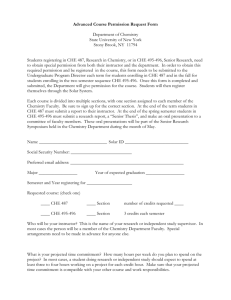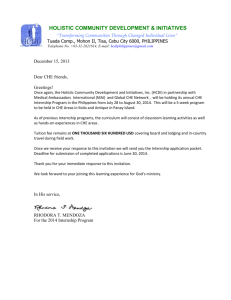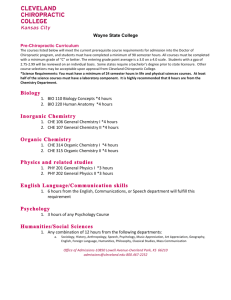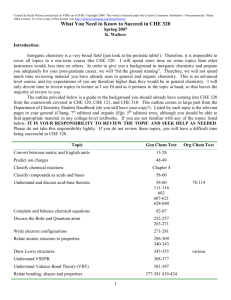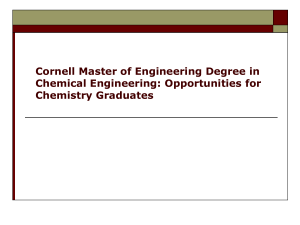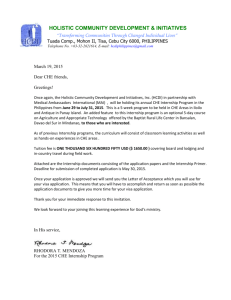New Frontiers in Chemical Engineering: Impact on Undergraduate
advertisement
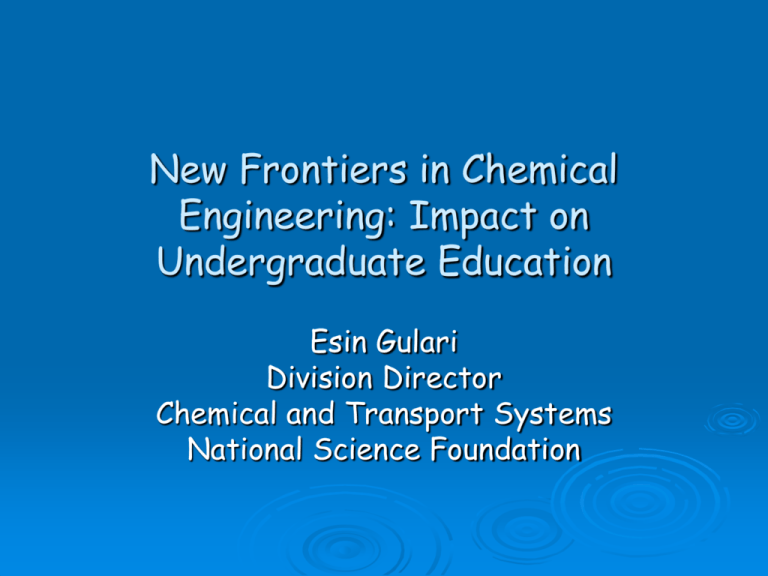
New Frontiers in Chemical Engineering: Impact on Undergraduate Education Esin Gulari Division Director Chemical and Transport Systems National Science Foundation Outline History of Chemical Engineering Strength-Weakness-OpportunityThreat Analysis Chemical Engineering Workforce Data and Trends CHE Frontiers activities/documents CHE relative to other disciplines New Curriculum History of Chemical Engineering 1900 Initial curriculum consisted of separate courses in chemistry and conventional engineering Decade I (1905-1915) Industrial Chemistry Metallurgy Electrochemistry Steam and Gas Tech. Chemical Manufacture Hydraulics Industrial Chemistry Surveying History of Chemical Engineering Decade Unit Operations Decade Materials & Energy Balances II (1915-1925) Unit Operations Descriptive Geometry III (1925-1935) Materials and Energy Balances Contracts Reduction in Mechanics & Machine Design History of Chemical Engineering Decade CHE Thermo. Process measurement & control More Physical Chem., Unit Operations Decade IV (1935-1945) CHE Thermodynamics Process Control Industrial Chem. Mechanics Foreign Languages V (1945-1955) Applied Kinetics Process Design Report writing & speech Organic Chemistry Metallurgy Applied Kinetics Reactor Design Machine Design Steam and Gas Tech. History of Chemical Engineering Decade VI (1955 -1965) Transport Phenomena Physical Measurements Differential Equations Computer Programming Decades Graphics Transport Phenomena Process Dynamics Process Engineering VII – X (1965 -2005) Minor changes Less Unit Ops. Less Material & Energy Balances Evolution of CHE Curriculum Increasing Emphasis in Underlying Sciences Development of Unit Operations Decline in Industrial Chemistry 1915 1925 1935 1945 1955 1965 Current Landscape of CHE Strength: Knowledge of processes on both molecular to macroscopic scales allows CHEs to work on the most exciting technology areas. Weakness: While CHE practice has evolved dramatically, the core curriculum has undergone minor changes in the past 40 years. Current Landscape of CHE Opportunity: To convey the excitement of CHE practice to students, to equip them to be versatile problem-solvers, to give them solid grounding in fundamentals and tools for engineering analysis and synthesis, illustrated by examples drawn from the breadth of industry and practice Biology has become a more molecular and quantitative science. There are new methods of incorporating new technology for education. Chemical Industry (CI) Trends The CI is cyclical. The CI is increasingly global. Mergers of companies and product lines happen often. Chemical companies are becoming life science companies and spinning off chemical units. Virtual companies provide out-sourced services including research. Time-to-market for new products has dramatically decreased. New CHE workforce can expect to have multiple jobs in their careers. Workforce Issues Public perception of “chemical” is negative. Potential students don’t know the role and contributions of CHEs in emerging technologies (biotech., nanotech., infotech.) Enrollments are small relative to other engineering disciplines Enrollments appear to be cyclic. Employment opportunities are diverse. Other disciplines are embracing molecular engineering. U.S. CHE Degrees 1966-2000 Science & Engineering Indicators (NSF 02-327) Initial Placement for BS 00-01 Other Graduate/Professional 11% 2% 1% Unemployed 9% Government 2% 19% Unknown Employment AICHE Career Services Industry 56% Industry Industrial Employment of BS Other Business services ES: Environmental ES: Research ES: Design&Construction Pulp & Paper Biotech/Pharma Materials Food/Consumer Fuels Electronics Chemical 0 5 10 15 20 Percent Industrial Employment of BS CHEs AICHE Career Services 25 BS Starting Salaries CHE leads all fields Boston Globe, April25, 2003 Chemical Engineering Frontiers (Graduate Education and Research) Beyond Molecular Frontier: Challenges for Chemistry and Chemical Engineering [Structures and Cultures of CHEM & CHE Disciplines: The Common Chemical Bond] NRC Report with six workshop documents • • • • • • The Environment National Security and Homeland Defense Materials Science and Technology Energy and Transportation Information and Communications Health and Medicine Chemical Engineering Frontiers (Undergraduate Education and Curriculum) CCR/NSF Curriculum Workshops 2002 Council of Chemical Research Annual Meeting, CHE Department Chairs Session Three planning workshops, “New Frontiers in CHE” supported by NSF • Workshop I: Orlando, Jan., 2003 • Workshop II: Austin, April 2003 • Workshop III: Cape Cod, June 2003 [Led by Bob Armstrong, CHE Dept. Chair, MIT] http://www.ccrhq.org/ Chemical Engineering Curricula Chemical Engineering at the Center Materials Science Computer Science. Physics Chemistry. Biology. Electrical Eng. Chem. Eng. Civil Eng. Mathematics. Mechanical Eng.. Chemical Engineering is connected to many disciplines Opportunities for New Curriculum CHE is uniquely positioned at the interface between molecular sciences and engineering. It can significantly contribute to emerging technologies: Alternate/renewable energy Better health National security Improved environment Elements of New Curriculum The enabling sciences are: Chemistry, Biology, Physics, Mathematics Core chemical engineering principles: Molecular transformations Multi-scale analysis Systems approach to solving problems Chemical engineering design contains: Process design Product design The Frontier CHE Curriculum Decade XI (2005 -2015) Molecular engineering Biology Product Design Systems Analysis Molecular Transformations Multi-scale Analysis Process/Product Design Increasing emphasis in biology and integration 2005 2015 ?? ?? ?? ??

